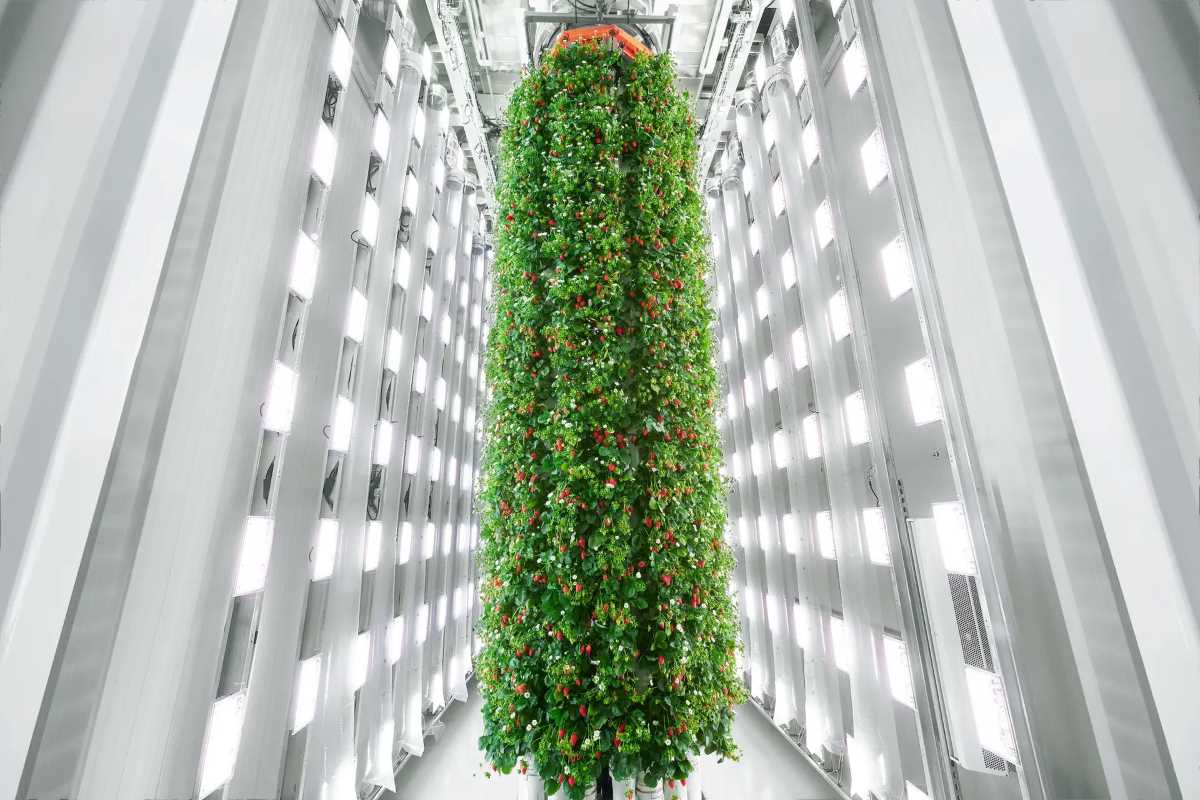Significant strides have been made toward more sustainable, accessible, and environmentally friendly food production with the opening of the world’s first large-scale indoor vertical strawberry farm in Richmond, Virginia. This innovative project is backed by an international team of scientists who see this new phase of agriculture as a solution to address the growing global demand for food.
A Breakthrough in Sustainable Agricultural Production
Plenty Richmond Farm is designed to produce more than 4 million pounds of strawberries per year, grown in vertical towers that are 30 feet tall, while occupying less than 40,000 square feet (approximately one acre). This is a fraction of the space traditionally required for strawberry production, which also depends on seasonal and environmental factors that limit yields.
According to the company, the strawberries will come from Driscoll’s, a globally recognized firm, and they are expected to be available in supermarkets by early 2025.
Virginia Governor Glenn Youngkin stated: “Plenty’s farm will boost local agricultural production and foster economic development, while diversifying risks and protecting the environment. We are excited to support their innovative approaches that will revolutionize the industry.”
The Expansion of Vertical Farming
To date, commercial vertical farming has primarily focused on leafy greens such as lettuce. However, this technological advance has expanded the range of what can be grown in vertical structures. At Plenty’s farm, strawberries are grown under controlled conditions of temperature, light, and humidity, spread across 12 growth rooms. This environment also allows for more efficient pollination, reducing waste and contributing to uniform fruit quality.
Arama Kukutai, CEO of Plenty, said, “This farm is a model of the positive impact that climate-independent agriculture can have and a proof that vertical farming can deliver the crop diversity, local production, and large scale we need to safeguard the global food system in the future.”
Kukutai explained that this farm is the result of 200 research trials conducted over the past six years to perfect the cultivation of strawberries with consistent, peak-season flavor, available year-round.
Innovation and Sustainability in Strawberry Production
A standout feature of the farm is that it uses 97% less land and up to 90% less water than conventional farming, while eliminating the use of pesticides. Additionally, the controlled environment and shorter supply chain reduce the risk of pathogens in the crops, improving both food safety and sustainability.

Paul Gauthier, a professor of protected cropping at the University of Queensland, explained that while vertical farms offer consistent, high-quality yields, they require a significant amount of energy for lighting and airflow. However, he suggested that adjusting light cycles and sensors to align with photosynthesis cycles could significantly reduce energy costs without sacrificing productivity.
Gauthier highlighted that by modifying the growing environment, he was able to triple strawberry yields in his experiments, from 4.4 pounds to 13.2 pounds per plant, demonstrating the enormous potential of controlled agriculture.
The Future of Agriculture and Food Security
The opening of this vertical farm marks a pivotal point after years of scientific research. Collaborators include renowned institutions such as the University of Queensland, Macquarie University, Wageningen University, the University of Florida, the University of the Basque Country, the CAS Center of Excellence in Molecular Plant Sciences, and the Shanghai Institute of Plant Physiology and Ecology.
Vertical farming promises to be a crucial tool in addressing global food production challenges. With the world population projected to increase over the coming decades, it is estimated that agricultural production must increase by 70% by 2050. This technology could be key to achieving this goal by maximizing the efficient use of resources such as water and land, while minimizing environmental impact.
A Collaboration for a Sustainable Future
Soren Bjorn, CEO of Driscoll’s, expressed his enthusiasm for the partnership with Plenty: “By combining our 100 years of agricultural expertise and proprietary varieties with Plenty’s cutting-edge technology, we can deliver the same flavor and consistent quality our customers love, now grown locally. This innovative new farm is a powerful step forward in continuing to drive the growth of the strawberry category in new ways for our customers and consumers.”
The Plenty Richmond model is an example of how technology and science are transforming agriculture toward a more sustainable future, where local, large-scale production becomes a reality without compromising on quality or the environment. This holistic approach could mark a turning point in the way food is produced, distributed, and consumed globally.
For more information, visit: www.plenty.ag



















